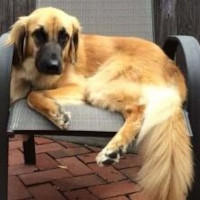Appearance of the Rottaf
|
| The Rotaff will be a large dog. At maturity, it will weigh at least 30 kilos. More than likely, a male will weigh over 43 kilos. He'll also be rather tall. Most Rotaffs measure at least 56 centimetres in height. He may be one of a variety of colors. He may be black and white, or black and tan. It can be brown or black all over. He may inherit tan markings above his eyes like the Rottweiler parent. His coat will be dense and his hair is likely to be short. He will have a muscular build. His tail may be long like the breed of Afghan Greyhound parents, or may be short like the breed of Rottweiler parents. His chest will be broad and deep. His ears will probably be of medium length, and he may have feathering on his legs and ears. The texture of its hair will be silky, and some compare it to human hair. |
Temperament of the Rottaf
|
| The Rottaf is a reserved dog. Because of its Rottweiler parentage, it will probably have to be with someone and decide that a new person is “okay” before it will accept a stranger. Even the Afghan Greyhound part generally dislikes strangers. He may even be a family dog. He may shun or ignore visitors. He can be described as an “independent thinker”. This often makes him difficult to train. However, patience and perseverance are essential when working with the Rottaf. He's very intelligent, but it can be tricky to understand why he needs to do something you want him to do. Even well-trained Rottaf can refuse to cooperate until they understand how actions can benefit them. Surprisingly, food doesn't always motivate the Rottaf. Repetition is the key to successful Rottaf training. |
Needs and activities of the Rottaf
|
| The Rotaff will be a moderately active dog. However, he's not necessarily a dog you can let loose in the yard for a game of fetch. He'll do best in a house with a fenced-in yard, with a fence over 1.80 meters high to make sure he doesn't jump over it. The breed of Afghan Greyhound parents is known to scale fences and, once he's out of the fence, he'll run and can be almost impossible to catch. He'll enjoy a walk with you around the neighborhood, but he should remain on leash at all times. The dog park is not the best place for the Rottaf. His personality is simply not conducive to being with lots of strange dogs at the same time. Don't forget that the Rottaf needs sufficient exercise not only to maintain a healthy weight, but also to prevent him from getting into mischief. |
Maintenance of the Rottaf
|
| The Rottaf won't require much maintenance. Brushing it once a week should be enough to get rid of any excess hair. However, he may tend to shed more in spring and autumn, like most dogs. During heavy weather, brush him two or three times a week. Note: it's also important to get the Rotaff used to a grooming routine. While the breed of Afghan Greyhound parents is accustomed to grooming, the Rottweiler can be quite sensitive to touch. Start a grooming routine when your Rotaff is young, so he'll be comfortable with the regimen as he gets older. Brush his teeth two or three times a week to prevent bad breath and tartar build-up. To prevent tooth decay, brush daily. Clip his nails every two or three weeks, especially if you can hear them clicking as he walks. |









 English (United Kingdom)
English (United Kingdom)